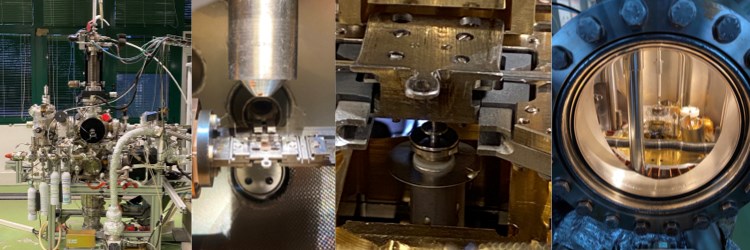

A scanning tunneling microscopy laboratory for the investigation of structural and electronic properties of solid surfaces at the nanoscale, with specific interest in describing their evolution during surface processes.
The STM laboratory includes two UHV systems equipped with a variable temperature Omicron VT-STM and a low temperature Omicron LT-STM.
The VT-STM has been modified in-house to allow for in-situ and in-operando measurements in the 140 – 900 K temperature range under exposure to reactive gases (O2, H2, CO, NO, etc.) at pressures up to 10-6 mbar. This system is ideal for the investigation of the kinetics of surface processes, such as elementary steps of catalytic reactions or growth and self-assembling, as well as for atomically resolved structural characterization of metal and oxide surfaces.
The LT-STM, for imaging at 4K, is capable of atomic scale resolution on weakly interacting adsorbates such as CO2 and organics of biological interest such as amino- and carboxyl- functionalized molecules. The LT system has been integrated with a home-built setup for single molecule vibrational spectroscopy measurements.
For a limited fraction of their activity (~10-15%), both systems are offered to external users through the NFFA-Europe program.
Instrumentation: The technical capabilities of the laboratory have been further improved with the development of FAST, an add-on module that can upgrade virtually any scanning probe microscope to video rate imaging, allowing the investigation of dynamical processes at surfaces with unprecedented time resolution. FAST requires no modification of the existing scanner hardware, and its operation is totally transparent with respect to the existing electronics and acquisition software. The module, initially developed in collaboration with the Elettra Electronic Workshop group, has been improved in the recent years in collaboration with the Technical University of Munich and ICN2 in Barcelona. FAST can now routinely reach acquisition rates up to 100 frames/s while maintaining atomic resolution and its capabilities have been extended to atom-tracking and Fast-AFM. The user-friendliness of FAST was completed by the development of new acquisition and analysis softwares. FAST can now be purchased by contacting ILO-Elettra.
STRAS - Surface sTructure and Reactivity at the Atomic Scale
The research activity of the group is dedicated to the study of surface structure and catalytic processes at the atomic scale. STM results are typically complemented by spectroscopic measurements and DFT calculations, both performed through external collaborations, inside and outside IOM.
In this context, two main research topics are presently addressed:
Growth, properties and reactivity of carbon-based 2D layers. Growth mechanisms for pristine and (N/B/TM-)doped graphene layers are investigated at the atomic scale during the growth process at technologically relevant temperatures and on both model surfaces and polycrystalline metal substrates, under hydrocarbon exposure and with time resolution up to video rate and above. Structural and electronic properties of the produced layer are investigated by VT-STM, LT-STM and STS, which are complemented by XPS, UPS and XPEEM/LEEM experiments. The reactivity of the layer is investigated by VT-STM under gas exposure. Experimental results are rationalized thanks to numerical simulations.
Self-assembling, structure and reactivity of organic layers. The systems of interest are thin films of organic semiconductor molecules (polyacenes, porphyrines, phthalocyanines) on transition metals or 2D materials. The assembling dynamics are investigated by means of both LT- and VT-STM. The morphology and the structure of the thin films are characterized by LT-STM at 4K and are complemented by electronic (STS) and vibrational (IETS) spectroscopy measurements at atomic/molecular level. STM/STS results are combined with RESPES, NEXAFS and SFG experiments and rationalized by numerical simulations (all of them performed through external collaborations).